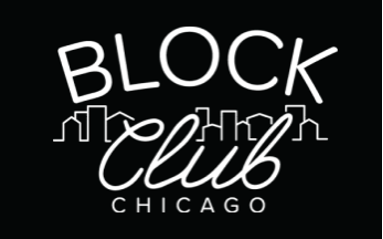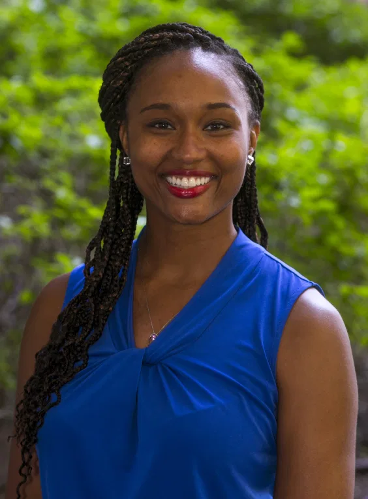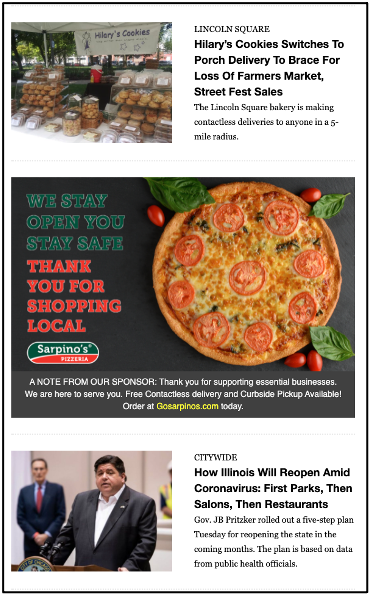

Published on July 20, 2021 and written by Emily Roseman
Maple Walker Lloyd is the only full-time employee on the 21-person team at Block Club Chicago who is dedicated to bringing in earned revenue, so she’s a busy person. When Block Club joined the GNI-INN Sponsorships Lab in the fall of 2020, she knew she needed to focus on a clear, concrete way that she could help build earned revenue at an outlet that had no earned ad revenue the previous year.

With more than 100,000 daily newsletter subscribers, the team knew there was potential for newsletter sponsorship opportunities. So Maple got to work securing these deals.
Block Club Chicago is a local, nonprofit news outlet that covers Chicago’s diverse neighborhoods. Founded in 2018, the outlet has quickly become a leading source of reporting on the city and a model for creative revenue experimentation.
Lloyd joined the team in July 2019 as director of development and community engagement. At that point, Block Club Chicago had no system to sell newsletter advertising but would place an ad here or there on request. At the beginning of 2020 the outlet started offering ads systematically. By the end of 2020, just five months after joining the GNI-INN Sponsorships Labs, the organization generated over $20,000 entirely from newsletter ads.
From the start of the Lab in October 2020 through May 2021, Block Club grew its earned advertising revenue 10% year over year (YOY) and drove a 15% increase in average revenue per client.
Lloyd cites the program’s coaches as key drivers for Block Club’s earned advertising revenue success and experimentation — and particularly Susan Scott who, in addition to her role as a coach at Blue Engine, is the chief growth officer for UNC-TV. Through Scott’s guidance, Lloyd launched an advertising referral program for clients to build on Block Club’s growing newsletter advertisement operation. Lloyd said, “It’s challenging because we don’t have the bandwidth to implement a lot of our ideas to increase earned revenue. It wasn’t until we joined the training program that my coach, Susan, was able to reframe my thinking about how we could tackle earned revenue in simple ways.”
Block Club Chicago was one of seven outlets that participated in the first cohort of the GNI-INN Sponsorships Lab, a program focused on accelerating revenue for nonprofit news outlets from advertising, sponsorship, and underwriting dollars. Blue Engine Collaborative, a new consortium of independent consultants and advisers with deep experience in driving audience and revenue at for-profits and nonprofits, led the programming that lasted six months and included a blend of virtual programming, intensive coaching, a community of shared practice, and a capacity-building grant. See the Nonprofit News Guide to Earned Revenue for best practices from the program. Across revenue from direct sold advertising, sponsorships and underwriting, and events, the seven publishers in the Lab reported more than 81% YOY growth.
Block Club sold its first newsletter ad in March 2020. Lloyd brought in eight more clients through the end of the year, and six more by May 2021.
Block Club offers 10 newsletters, including two free, daily products. A daily newsletter and an afternoon coronavirus update go out to 100,000 people every weekday, with 27% of recipients opening it. Block Club also sends six neighborhood focused newsletters to its paid subscribers twice per week, and two free newsletters twice a week to additional neighborhoods. Those neighborhood lists range from 2,000 to 6,000 subscribers each, with open rates at an impressive 37% to 48%.
One of the first steps to take when selling newsletter advertising is determining inventory (or availability) and setting prices.
Block Club’s editor in chief helped figure out the pricing after consulting with a few contacts, and eventually landed on a pay-per-edition system with an incentive to bulk buy ads. A client can pay $1,200 for a single ad in the morning newsletter, $3,000 for 3 ads ($1,000 per ad), all the way up to $12,000 for 20 ads ($600 per ad). For the neighborhood-specific newsletters, the smaller list sizes merit a lower charge. A client can pay $300 for 1 ad, $250 each for 2 ads, and the cost lowers to $130 each for 12 ads.
Use this resource: See page 26 of the Nonprofit News Guide to Earned Revenue for pricing best practices, including how to consider the two primary factors for pricing: willingness to pay and competitive market value. As Lloyd learned in the Lab, too, with pricing the most important thing is to experiment with what you can offer by framing the opportunity around your prospects’ needs — and providing solutions to those needs.
For inventory, the Block Club Chicago team knew they did not want to oversaturate their valuable newsletters with too many ad spots. So, they decided to only offer one ad spot per newsletter edition. This limit enhances the reader’s experience, but also allows Lloyd to guarantee the client exclusivity. And, perhaps most importantly, limiting the inventory streamlines the work for this lean and busy local team. In the Lab, Lloyd learned how narrowing inventory in this way (and as Block Club has done, selling out that inventory quickly) is also a way to create a premium or demand that can allow you to raise prices.
Lloyd says the key to her success in actually selling these new positions was the GNI-INN Sponsorships Lab and Susan Scott, who helped her reframe her thinking of earned revenue as a process of a few, simple building blocks.
One of those foundational building blocks is to be continually experimenting and pursuing what you can in the simplest way possible — based on what your capacity allows. For Lloyd, that involved devising a simple plan to launch a new, email ad referral program: If an existing client refers another to Block Club’s ad program who then buys an ad, the referring client gets one ad free.
The referral program began in January 2021 when Lloyd announced it to nine existing or former clients. Two responded and thought it was a great idea. One client placed two additional ads thanks to the referral program. Lloyd plans to keep offering this referral program to grow the client base, especially in this early phase of newsletter advertising operations.
Lloyd also started another outreach by promoting Block Club’s advertising opportunities in the daily newsletter. A quarterly note will remind newsletter subscribers that the outlet is always looking for community partners to help support Block Club’s impactful storytelling.
On a recent push to the daily list, 10 people responded with advertising inquiries. Four turned out to be real prospects. Two were stalled by budget issues, but two moved forward with advertising deals.
TIP: If you don’t hear back from a client, always follow up. Lloyd initially interpreted no response from her email outreach to mean people weren’t interested. She followed up by email and proved herself wrong. Some of her prospects thanked her for getting back in touch, saying they had forgotten to respond or that their budget initially hadn’t allowed for ads, but now they were interested. The Lab emphasized to continually follow up and to never assume that silence is a no.
Lloyd’s biggest sales come from the daily newsletter. The smaller, neighborhood specific lists are the cherry on top. Lists sorted by location allow clients to reach specific pockets of people across Chicago, which can come in handy when promoting a neighborhood event. They help Lloyd reach out to distinct, and different, prospects across Chicago and the surrounding region.
Typically, clients buy ads in sets of two or three at a time. Sometimes a client will buy a few ads in the daily newsletter and some in the neighborhood lists for one campaign. Lloyd emphasizes that she remains flexible in this part of the sale: working with the clients to understand their needs so she can recommend the right ad mix and frequency. This is a key part of solutions or consultative selling that the Lab emphasized is the key for publishers like Block Club to maximize their earned revenue potential.
Clients are local businesses, a mix of universities and schools, and nonprofit organizations. This past year, Block Club sold five ads over two to three month to the U.S. Census Bureau, which needed help reaching certain communities across Chicago.

Here’s how the sales process works at Block Club: Once Lloyd has a lead for a client, she’ll send a document that reviews the outlet’s newsletter sponsorship options. This email usually prompts a conversation in which Lloyd can learn more about the client’s needs and recommend a newsletter advertising package. From initial outreach to a sale can take a few days, weeks, or months. Some clients reach out months in advance; others reach out last minute. Whatever the time frame, Lloyd is ready to make the sale, part of the Lab emphasis on always striking while the iron is hot.
After Lloyd makes the sale, the client sends their ad with the ratio requirements, and then a link to the site where they want the ad to jump when clicked. Block Club requests that the ads are no more than 30 words.
Lloyd then sends the editors the ad, URL, and the date(s) the ad will run. Block Club doesn’t guarantee specific placement for newsletters ads (sometimes an ad will be placed in the middle of stories, and other times, near the end), so it’s up to the editor to upload and make the judgment call of where to place the ad. It depends on what’s being published that day, and the editor will sometimes move the ad further down the page if there’s breaking news in the newsletter.
After they run the ad, Lloyd sends an email with a link to the newsletter to the client. If a client asks, Lloyd will send the open and click rate of the newsletter where the ad ran. This is an opportunity to emphasize the value of Block Club’s audiences and the impact of the campaign and how it met the clients’ needs, closing a key part of the loop on the solutions selling process.
Lloyd and the Block Club team are just getting started with earned revenue, and are excited to build on the successes that she gained through the Lab.
Lloyd has her sights set on getting a sponsor for an entire newsletter. That might look like a $100,000 package where the client gets its logo and an ad in every single edition of the daily newsletter for a year. Through continued growth, Lloyd also hopes to one day have a direct report who can fully jump with her into earned revenue work — strategizing and pitching opportunities like this one to more clients.
Tip: Just try it. Here’s Lloyd’s advice for other news outlets just getting started with earned revenue: Find out what you can do and just try it and see what works. Newsletter ads could either become a steady source of revenue, or it could not work for your audiences or in your market. Either way, it’s worth trying and you’ll learn quickly. Especially if your news outlet already has a large and engaged email list, the time and effort to get the ball rolling is more than worth the potential for any return on investment.
Back to top